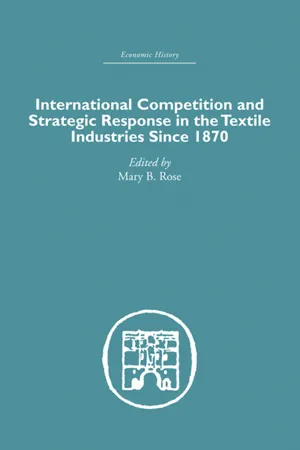![]()
NOTES
INTERNATIONAL COMPETITION AND STRATEGIC RESPONSE IN THE TEXTILE INDUSTRIES SINCE 1870
By MARY B. ROSE
Thanks are due to Dr Geoff Jones and Dr Maurice Kirby for their advice in preparing this Special Issue and to numerous anonymous referees.
1. S. Hirsch, Location of Industry and International Competitiveness, (Oxford, 1967) p.24; GATT, A Study of Cotton Textiles (Geneva, 1966) p.7.
2. S. Kuznets, Economic Change, (New York, 1953), p.254.
3. B. Toyne, et al. (eds.), The Global Textile Industry (1984), pp.66–7.
4. Hirsch, Location of Industry, p.129.
5. L.T. Wells, ‘Product Life Cycle for International Trade’, Journal of Marketing, Vol.3 (1968), p.2.
6. Ibid., p.5.
7. Ibid., p.6.
8. G. Clark, ‘Why Isn’t the Whole World Developed? Some Lessons from Cotton Mills’, Journal of Economic History, Vol.47 (1987), pp.141–173; M. Wilkins, ‘Efficiency and Management: A Comment on Gregory Clark’s ‘Why Isn’t the Whole World Developed?’ Journal of Economic History, Vol.47 (1987), pp.981–83.
9. Toyne, Global Textile Industry, p.70; Financial Times, 2 June 1988.
10. Toyne, Global Textile Industry, pp.151–3.
11. Ibid., Appendix 2, Table A 2.9.
12. Ibid., Appendix 2, Table A 2.10.
13. F. Vibert, ‘Problems in the Cotton Industry’, Oxford Economic Papers, Vol.18 (1966), p.318.
14. Ibid., pp.315, 319.
15. B. Vitkovich, ‘The UK Cotton Industry’, Journal of Industrial Economics, Vol.3 (1955), p.252.
16. W. Lazonick, ‘Industrial Organisation and Technological Change: The Decline of the British Cotton Industry’, Business History Review, Vol.57 (1983), p.213; J.A. Blackburn, ‘The Vanishing UK Cotton Industry’, National Westminster Bank Review (1982), pp.47–8. Toyne, Global Textile Industry, p.168, GATT, Cotton Textiles, p.13.
17. M.W. Kirby, ‘The Lancashire Cotton Industry in the Interwar Years: A Study of Organisational Change’, Business History, Vol.16 (1974), pp.146–7.
18. W. Lazonick, ‘The Cotton Industry’, in B. Elbaum and W. Lazonick (eds.), The Decline of the British Economy: An Institutional Approach (Oxford, 1986), p.20; GATT, Cotton Textiles, p.13; Toyne, Global Textile Industry, p.168.
19. D.H. Aldcroft, ‘The Entrepreneur and the British Economy, 1870–1914’, Economic History Review, Vol.17 (1964), pp.113–34.
20. L.H. Sandberg, ‘American Rings and English Mules: The Role of Economic Rationality’, Quarterly Journal of Economics, Vol.LXXIII (1969), pp.25–43.
21. Lazonick, ‘The Cotton Industry’, pp.18–50, J.H. Bamberg, ‘The Rationalisation of the British Cotton Industry in the Interwar Years’, Textile History, Vol.19 (1988), pp.83–102.
22. For the role of the chain stores’ manufacturers, see also S.D. Chapman, ‘Mergers and Takeovers in the Postwar Textile Industry’, Business History, Vol.XXX (1988), pp.219–239.
THE BRITISH COTTON INDUSTRY AND INTERNATIONAL COMPETITIVE ADVANTAGE: THE STATE OF THE DEBATES
By WILLIAM MASS and WILLIAM LAZONICK
23. The main contributions to the debate have been L. Sandberg, Lancashire in Decline (Columbus, 1974); W. Lazonick, ‘Competition, Specialisation, and Industrial Decline,’ Journal of Economic History, Vol.XLI No.1 (1981); idem, ‘Factor Costs and the Diffusion of Ring Spinning Prior to World War I,’ Quarterly Journal of Economics, Vol.XCVI No.1 (1981); idem, ‘Industrial Organisation and Technological Change: The Decline of the British Cotton Industry,’ Business History Review, Vol.LVII No.2 (1983); W. Lazonick and W. Mass, ‘The Performance of the British Cotton Industry, 1870–1913’, Research in Economic History, Vol.IX (1984); L. Sandberg, ‘The Remembrance of Things Past: Rings and Mules Revisited,’ Quarterly Journal of Economics, Vol.XCIX, No.1 (1984); W. Lazonick, ‘Rings and Mules in Britain: Reply,’ Quarterly Journal of Economics, Vol.XCIX No.1 (1984); G. Saxonhouse and G. Wright, ‘New Evidence on the Stubborn English Mule and the Cotton Industry, 1878–1920,’ Economic History Review, second series, Vol.XXXVII No.4 (1984); W. Lazonick, ‘The Cotton Industry,’ in B. Elbaum and W. Lazonick (eds.), The Decline of the British Economy (Oxford, 1986); W. Lazonick, ‘Stubborn Mules: Some Comments,’ Economic History Review, second series, Vol.XL No.1 (1987); G. Saxonhouse and G. Wright, ‘Stubborn Mules and Vertical Integration: The Disappearing Constraint?’ Economic History Review, second series, Vol.XL No.1 (1987); G. Clark, ‘Why Isn’t the Whole World Developed?: Lessons from the Cotton Mills,’ Journal of Economic History, Vol.XLVII No.1 (1987); M. Wilkins, ‘Efficiency and Management: A Comment on Gregory Clark’s “Why Isn’t the Whole World Developed?”’ Journal of Economic History, Vol.XLVII No.4 (1987); G. Clark, ‘Can Management Develop the World?: Reply to Wilkins’, Journal of Economic History, Vol.XLVIII No.1 (1988). See also B. Elbaum, ‘Cumulative or Comparative Advantage?: British Competitiveness in the Early Twentieth Century’, World Development, forthcoming 1990. For an admirable summary of the more general debate on entrepreneurial performance in Britain in the late nineteenth and early twentieth centuries, see P.L. Payne, British Entrepreneurship in the Nineteenth Century, (2nd ed. 1988), pp.43–60.
24. For elaborations of our perspective, see W. Lazonick, Business Organisation and the Myth of the Market Economy (Cambridge, 1991), Ch.1; W. Mass, ‘Mechanical and Organisational Innovation: The Drapers and the Automatic Loom’, Business History Review, Vol. LXIII No. 4 (1989); W. Mass, ‘Decline of a Technological Leader: Capabilities, Strategy, and Shuttleless Weaving, 1945–1974’, Business and Economic History, second series, Vol.XIX (1990).
25. S. Pollard, The Genesis of Modern Management (Harmondsworth, 1968); W. Lazonick, Competitive Advantage on the Shop Floor (Cambridge, Mass., 1990), Ch.1.
26. Lazonick, Competitive Advantage, Chs.3–4.
27. See D.A. Farnie, The English Cotton Industry and the World Market, 1815–96 (Oxford, 1979), Chs.2 and 8. On the nineteenth-century development of the British cotton industry more generally, see the excellent synthesis in S. D. Chapman, The Cotton Industry in the Industrial Revolution, (2nd...
